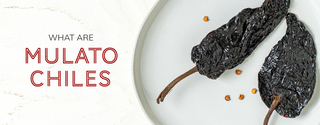What Are Mulato Chiles

What Are Mulato Chiles
Mulato chiles, botanically classified as Capsicum annuum, are the result of prolonged ripening of a poblano pepper. Fresh poblano peppers are left as long as possible on the plant to ripen; they turn a deep brown when they have reached peak ripeness. When dried, this mild chile develops deep chocolate and cherry notes.
Table of Contents
What Do Mulato Peppers Taste Like?
What Is Chile Mulato Used For?
How To Make Mulato Chile Powder
All About Mulato Chiles
Mulato peppers, pronounced “mu-LAH-to”, are mild chiles with a complex flavor profile. This pepper is one of the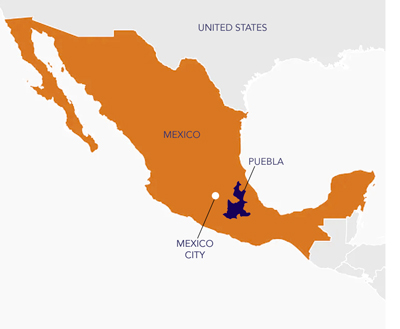 “holy trinity” of peppers used to make mole poblano; the other peppers in this sauce are Anchos and Pasilla Negros. This traditional Mexican sauce is made with chiles, fruit, nuts, and chocolate, developed in the Puebla region.
“holy trinity” of peppers used to make mole poblano; the other peppers in this sauce are Anchos and Pasilla Negros. This traditional Mexican sauce is made with chiles, fruit, nuts, and chocolate, developed in the Puebla region.
Along with its cousin, the Ancho, Mulato chiles have become a staple of Mexican cuisine. The original pods for this pepper were first developed in the Mexican state of Puebla and were a part of indigenous Mexican cooking as early as 800 BC.
If you’re interested in learning more about the flavors of chile peppers and are curious about the rich and complex Mulato, we can help you understand what they are and if they’re the right chile for a recipe in question.
For over a decade, Spices, Inc. has been sourcing, processing, and selling Mexican dried chiles. You can find our chiles in Mexican restaurants, with companies crafting hot sauces, in the tanks in micro-breweries, and with home cooks in their pantries.
We know about Mulato peppers and want to pass that knowledge along to you. We discuss what they are, where they come from, and how they differ from other, closely related peppers. We help you figure out how to prepare them for use and suggest ways to use them. We talk about how to store your peppers, how and where to shop for Mulato peppers, and what to look for when buying.
| Ingredients | Mulato chiles |
| Also Called | Chile mulato, mulato chile, or mulato chili |
| Recommended Uses | Moles, sauces, or stews |
| Flavor Profile | A bit sweet with hints of smoky chocolate, licorice, cherries, and coffee |
| Scoville Heat Units | 1,000 - 1,500 SHU |
| Botanical Name | Capsicum annuum |
| Cuisine | Mexican |
| How To Store | Airtight container in a cool, dark place |
| Shelf Life | 1-2 Years |
| Country of Origin | Mexico |
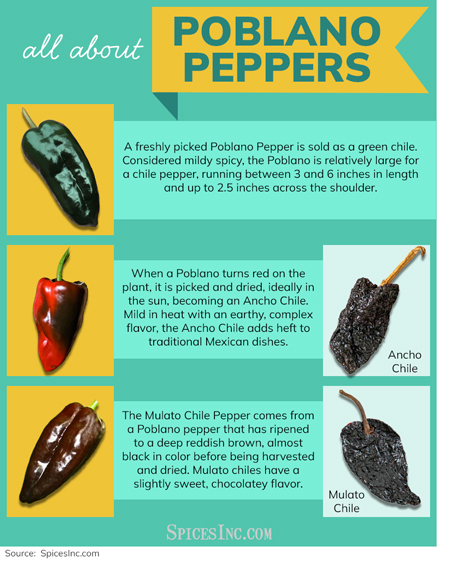 What Are Poblano Chiles?
What Are Poblano Chiles?
The poblano chile is the parent pepper of the Mulato and the Ancho chile. This plant is native to the Mexican state of Puebla and is commonly grown commercially and in personal gardens. The name poblano means “from Puebla”, but it also means “villager”. This pepper can be eaten at all stages of development. It is sold as a fresh poblano when it is picked while green. When it is allowed to mature to red ripeness and harvested, it is dried and sold as an Ancho. The final stage of its ripeness, when it turns brown on the vine, is when it is picked and dried as a Mulato.
Is There Another Name for Mulato Chiles?
The only alternate names that Mulato chiles go by are chile Mulato, Mulato peppers, or Mulato chili. They may occasionally be mislabeled as chiles negros or even Pasilla Negro, but neither of these names is correct.
Is Chile Ancho the Same as Mulato Chile
Anchos and Mulatos are not the same things. They are chile peppers from the same plant, though they are picked at different points in the plant’s maturity and then dried. Anchos are more fruity and earthy, while Mulatos are deeper and sweeter, with pronounced flavors of chocolate and coffee.
What Do Mulato Peppers Taste Like?
Mulato peppers have a deep and resinous flavor. They are sweet and mild chiles and taste like a combination of smoke, chocolate, licorice, cherries, and coffee.
How Hot Are They?
Mulato peppers are mild. They measure a family-friendly 1,000-1,500 Scoville Heat Units (SHU).
What Is Chile Mulato Used For?
Mole Poblano is far and away the most well-known dish associated with chile Mulato, but it can be used like any other sizeable dried chile.
It can be rehydrated and stuffed with sausage, rice, beans, or cheese. Once you rehydrate the Mulato, you can slice it and use it to stuff enchiladas. Or, mash it into a paste to stir into enchilada sauce or chili.
If you don’t rehydrate it, you can grind it into flakes or powder, stir into rice, toss over vegetables and meats, and bake or grill. You can mix it into butter and massage it into roast chicken or turkey for extra flavor.
How To Deseed Mulatos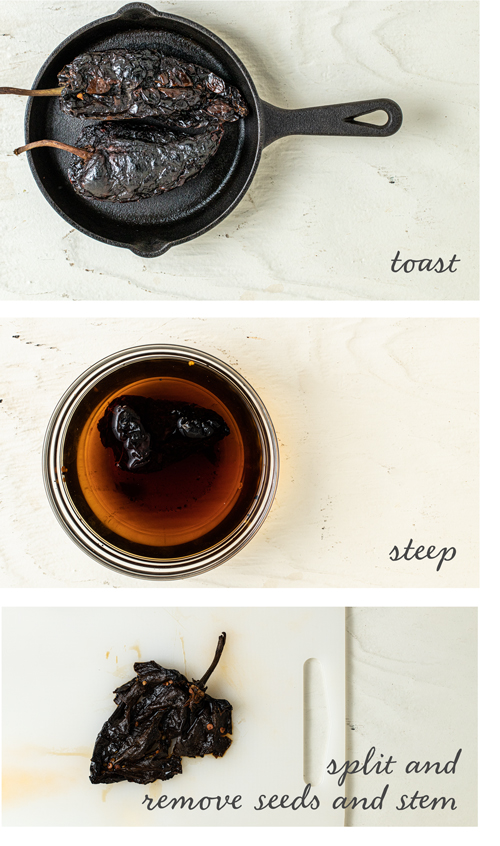
Mulatos are very easy to deseed. You can take a knife or use your finger and pull the pepper apart lengthwise. Most seeds should fall out; you can take your finger or something blunt, like a teaspoon, and clear out the papery veins and any seeds that cling to the veins.
How To Toast Mulatos
Toast these chiles in a dry pan, over medium-high heat, for 60-90 seconds, flipping as necessary to prevent scorching. You can press them down with a spatula to help them toast evenly.
You may see them start to puff up a bit, but you should primarily let your nose be your guide when they are done. They should smell sweet and smoky, not like they are charred or burnt.
We firmly believe that toasting is the first step to using Mexican dried chiles successfully.
How To Rehydrate Mulatos
Once your chiles are toasted, put them in a heatproof bowl. Pour boiling water over the Mulato peppers and let them steep for 25-30 minutes. Make sure they stay submerged; weight them down with a plate if necessary. They will become very soft. The skins should offer little to no resistance if you go to tear them. Drain the water and let the peppers get cool enough to handle. Then you can chop, tear, or mash them however you choose.
You can reserve the soaking water from Mulato chiles when making soups or sauces. It should be pleasant—primarily sweet and a little smoky, with hints of chocolate. We do recommend that you taste your chile water before using it.
How To Make Mulato Chile Powder
Once you have toasted your Mulato chiles, they are ready for grinding. Tear the peppers into smaller pieces and put them in a mortar and pestle or electric spice grinder. Use them right away or store them in an airtight container, away from sunlight and direct heat, for future use.
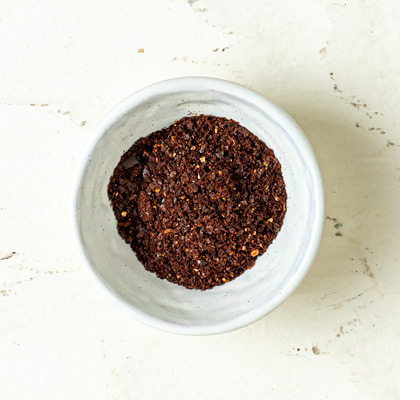
How Long Do They Last?
Well-stored, dried Mulato peppers can be kept in a pantry for roughly 1-2 years. They should be stored in an airtight container and not subject to heat, moisture, or direct sunlight.
We strongly recommend that dried chile peppers are not stored next to or above your stove. The heat from the stove can raise the overall air temperature in your storage container, which can cause latent moisture trapped in the chile to emerge—your chiles will sweat.
In an airtight container, that sweat has nowhere to go. Since moisture can’t evaporate, it could instead help introduce mold and mildew to your chiles.
When a Mulato is properly stored, it will be pliable and dry to the touch, with a vaguely leathery, wrinkled feel. It should smell rich, with hints of smoke and chocolate. Peppers should be discarded if they look ashy or pale, are brittle, or show any signs of mold.
The ultimate way to store dried chiles would be in a climate-controlled pantry. The temperature should not go below 60°F or above 72°F, and the humidity should be low. Storage containers need an airtight lid and should be opaque or well-guarded from sunlight. With these conditions in place, chiles should be viable for 2-3 years. Since this is not practical for most kitchens, we think you should expect a 1-2 year shelf life for your chiles.

Mulato Chile Substitution
The best substitute for a Mulato chile is its cousin, the Ancho. They share the same heat profile, measuring between 1,000-1,500 Scoville Heat Units (SHU). Their flavors are also similar, though the Mulato tends to be deeper and more chocolatey, while the Ancho has more fruit. You can also consider the Pasillo Negro a substitute for Mulato; it also has a SHU of 1,000-1,500, with chocolate and raisin notes.
What To Look For When Buying Mulato Chiles
The best Mulato peppers will have a somewhat leathery, wrinkled exterior and are soft enough to bend without breaking. It will look dark, dark purple, or even black. They should be, for the most part, whole and unbroken. They will have a rich aroma that smells like chocolate, raisins, and smoke.
Where To Find Mulato Chiles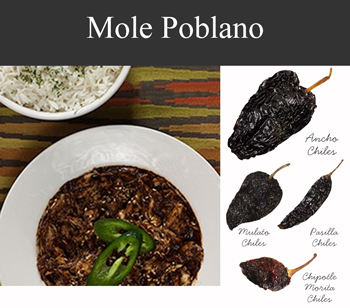
You can find Mulato chiles for sale in Mexican markets, grocery stores, and various online retailers. These shopping environments offer various positives and negatives.
Mexican markets usually benefit from a staff that is very familiar with dried chiles and can explain their differences. But they also tend to be small, which means their inventory may be slow-moving, so Mulato peppers can age on a shelf. They also have less ability to negotiate wholesale pricing, which often translates to higher prices for the in-store consumer.
Grocery stores, mainly if they are a large chain, have a good deal of clout in the wholesale market and can often secure lower prices at that end of the supply chain. This means they can charge the consumer less money and still make a profit. But they are primarily interested in buying the most popular chiles, so they generally don’t offer a broad selection of peppers.
The employees in a grocery store, from the buyers to the stockers, are usually not specialists regarding chiles. There’s a greater chance that the chiles in a grocery store are mislabeled, and there’s often limited expertise available if a consumer asks for clarification.
Big-box online retailers look attractive because of the convenience; you can shop from home, choose from a large selection of goods, and can often enjoy benefits like free shipping. But large retail houses are usually fulfillment centers for smaller businesses and have no claims of expertise in the products they sell. There is little to no oversight about the quality of chiles at point of sale.
Online specialty vendors usually build their business on product knowledge and selection. They are more likely to have employees with the skills and know-how to differentiate between Mulatos, Pasillas, and Ancho chiles.
Reputable retailers have developed methods that facilitate accurate order filling. They work to have minimal turnover and train their employees about their products. They develop company-wide familiarity with chiles, from order placement to final packaging, so customers can feel comfortable that they are getting the sort of high-quality chile peppers they deserve.
Mulato peppers are extremely easy to work with; they are big and easy to clean, with a mild heat and complex, savory flavor. They add a boost to just about any dish you want, whether you’re making salsa or roasting a chicken. The only limit with this chile is your imagination.
People around the world have benefited from the chiles of Mexico for hundreds of years, since Spanish conquistadores first came to Mexico in 1519. We invite you to learn more about Mexican dried peppers, so you can figure out how to make them work in your kitchen.

